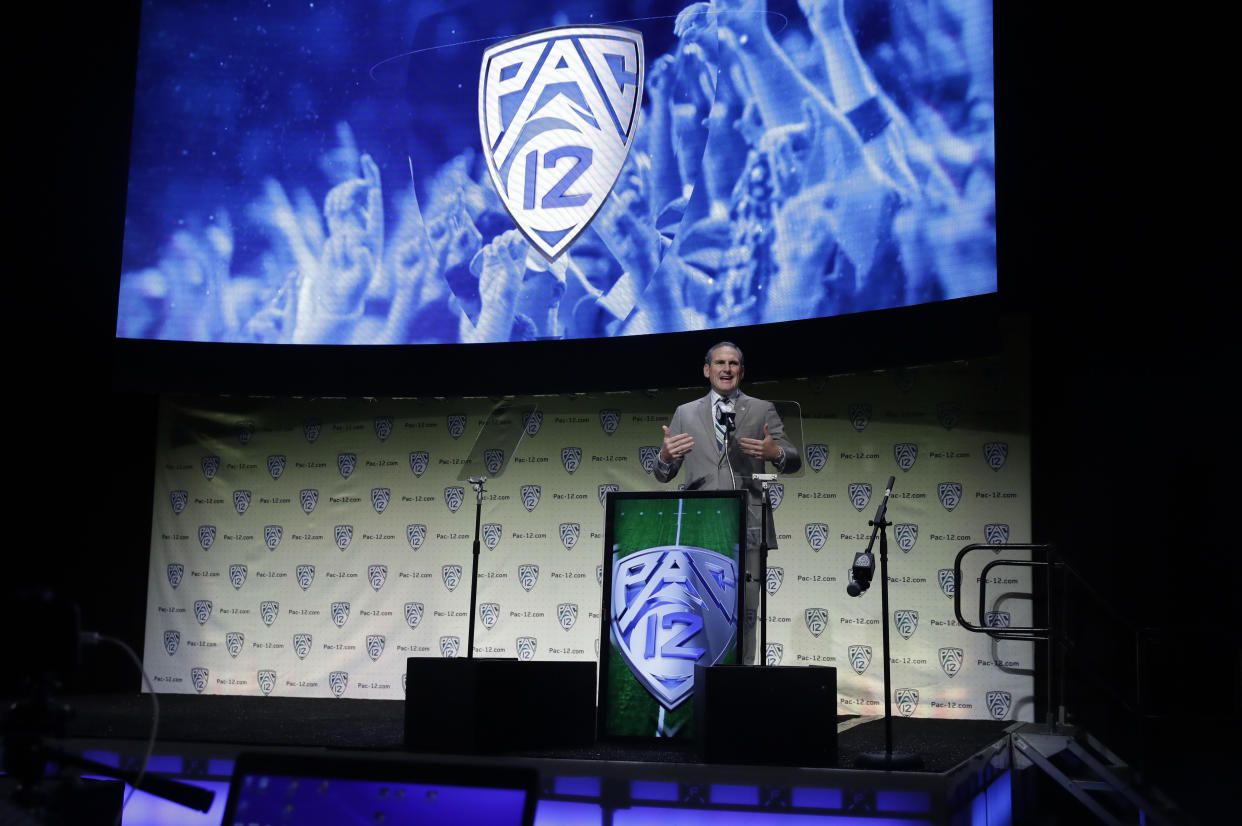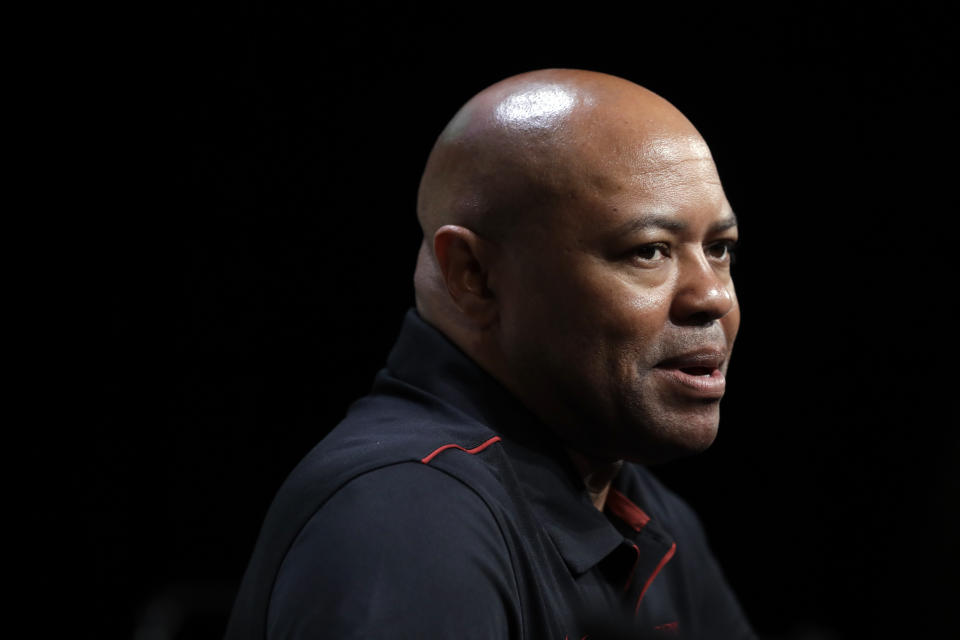The Pac-12 is falling behind, and not everyone agrees on how to fix it

LOS ANGELES — For years, the Pac-12 touted itself as the “Conference of Champions.”
It was a tagline that appeared in every form of conference marketing, from TV commercials to swag to social media.
We get it. No other league has won more national championships across collegiate sports.
By now, the tagline has become an almost ironic statement. Sure, the league continues to rack up titles in sports like golf, volleyball and gymnastics.
And yet, there were no signs of golfers or gymnasts on Wednesday in Hollywood, where the Pac-12 stages its annual football media day.
Football gets its own fancy media day because football pays the bills in college athletics.
And in that sport, the Pac-12 has been nowhere near the conference of champions lately.
Only one Pac-12 team has participated in the College Football Playoff the last four years and the league has compiled a 13-19 record in bowl games during that span.
The lack of success on the field directly contributes to the conference’s financial shortcomings compared to other major conferences as playoff appearances lead to tens of millions in extra cash for the league.
Washington head coach Chris Petersen knows firsthand about that. His team won the Pac-12 last season and still missed out on the playoff. But on Wednesday, Petersen said the big-picture issues are due to a number of factors.
“It’s not any one thing. I think it all matters,” Petersen said. “The scheduling, the resources. It just all adds up. So it’s, ‘OK, how did this happen? How did we get here and not here?’ Now you’re playing catch-up again.”
And it’s a big gap to close.

The Pac-12’s average revenue distribution per team in the 2017-18 fiscal year was reportedly $29.5 million, which was tied with the ACC for last place among Power Five conferences.
Even more alarming is just how far that number is behind the top two conferences, the Big Ten and SEC, which shelled out $54 million and $43.7 million, respectively, to its member schools.
This is a clear decline for the Pac-12, which was generating comparable dollar amounts to the SEC as recently as 2013, according to a New York Times report.
“We have to acknowledge many of the criticisms that the conference has received, and I can tell you that collectively we've taken a hard look at everything about how we're operating when it comes to football,” said Pac-12 commissioner Larry Scott.
He downplayed the concern of the revenue disparity, saying those numbers tend to be cyclical and insisting the Pac-12 will bring in the big bucks when it strikes new TV contracts in 2024.
Former UCLA coach Jim Mora doesn’t share such a rosy projection.
“Face reality and set aside the pride and recognize that they don’t have a good enough deal to represent what the Pac-12 should be on a national level,” Mora said. “Go after it because it’s a great brand of football.”
But it goes beyond a TV contract. Mora, who led UCLA from 2012-17 and played at Washington in the 1980s, also says there’s also a dearth of talent and passion out west.
“Young men on the West Coast, recruits, high school kids, have so many more options in life than kids down south. … In the South, football is very much a religion, it’s extremely important,” Mora said. “It’s a focus from a time that they’re very, very young. There’s huge alliance to the conference, to the schools.”
Stanford coach David Shaw, entering his ninth year at the helm, disagrees. Instead, he harped on scheduling as a major point of contention. That goes for both the difficulty of the opponents and the time of day.
“It’s not a talent deficiency. A lot of it has to do with scheduling. We play nine conference games and for most of us it’s really hellacious out-of-conference schedules,” Shaw said. “You get to those times in November where you’re playing your fifth conference game in a row, and even though you’re on a roll you lose that big game and that late-season loss really hurts you. And you may be able to go to the conference championship game and win it but that late-season loss knocks you out of contention for that playoff spot.”

Playing nine conference games isn’t unique to the Pac-12. Both the Big Ten and Big 12 also do so, but the SEC and ACC opt for eight conference matchups per season. Scott reiterated that the Pac-12 doesn’t plan to budge on nine.
Outside of knocking a game off the schedule, the conference could also greatly benefit from an expanded playoff field. It was created with a four-team format in 2014, and plenty of coaches continue to call for an increase to a eight teams or more.
Count Washington State’s Mike Leach as one of those.
“Only having four teams is idiotic, especially when you have five (major) conferences,” Leach said. “That doesn’t even make sense on its face.”
But wins and losses and playoff games don’t tell the whole story, either. There are inherent disadvantages to playing on the West Coast, where it can be tougher to gain national exposure as a player or program playing in later time slots.
“I’ll go toe to toe with anyone in America that disagrees with me. When you play so many games late at night, the people in the East Coast, they started watching games at noon and it’s 10:30 at night. They’re not watching another game,” Shaw said.
It’s not uncommon for Pac-12 games to kickoff at 7 or 7:30 p.m. on the West Coast. Those games will routinely finish into the wee hours of the morning back east. In recent years, those games have developed a reputation for bringing wild and exciting finishes so much so that a hashtag was organically created on social media: #Pac12AfterDark. The problem is the majority of the country may not be watching.
“They call it Pac-12 after dark,” Mora said. “It’s Pac-12 after everyone on the East Coast has gone to sleep is what it is.”
Scott was posed with the “after dark” kickoff question on media day and he said the league will consider starting more games in earlier time slots, some as early as 9 a.m.
That idea was instantly met with mixed reviews among the coaches in attendance.
Like most of these issues, it’s hard to get everyone to agree on a solution.
Whatever the answers are, the Pac-12 needs to find them soon. Otherwise the Conference of Champions may need to rebrand.
More from Yahoo Sports:

